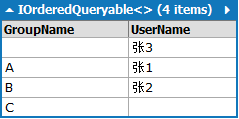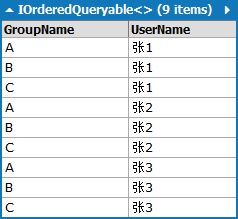1、先创建两个表Group、User,两表的关系是N:N

1 CREATE TABLE [dbo].[Group]( 2 [Id] [int] IDENTITY(1,1) NOT NULL, 3 [GroupName] [nvarchar](50) NULL, 4 CONSTRAINT [PK_Group] PRIMARY KEY CLUSTERED 5 ( 6 [Id] ASC 7 )WITH (PAD_INDEX = OFF, STATISTICS_NORECOMPUTE = OFF, IGNORE_DUP_KEY = OFF, ALLOW_ROW_LOCKS = ON, ALLOW_PAGE_LOCKS = ON) ON [PRIMARY] 8 ) ON [PRIMARY] 9 10 CREATE TABLE [dbo].[User]( 11 [Id] [int] IDENTITY(1,1) NOT NULL, 12 [UserName] [nvarchar](50) NULL, 13 [GroupId] [int] NULL, 14 CONSTRAINT [PK_User] PRIMARY KEY CLUSTERED 15 ( 16 [Id] ASC 17 )WITH (PAD_INDEX = OFF, STATISTICS_NORECOMPUTE = OFF, IGNORE_DUP_KEY = OFF, ALLOW_ROW_LOCKS = ON, ALLOW_PAGE_LOCKS = ON) ON [PRIMARY] 18 ) ON [PRIMARY]
2、测试数据

1 INSERT [dbo].[User] ([Id], [UserName], [GroupId]) VALUES (1, N'张1', 1) 2 INSERT [dbo].[User] ([Id], [UserName], [GroupId]) VALUES (2, N'张2', 2) 3 INSERT [dbo].[User] ([Id], [UserName], [GroupId]) VALUES (3, N'张3', 4) 4 5 INSERT [dbo].[Group] ([Id], [GroupName]) VALUES (1, N'A') 6 INSERT [dbo].[Group] ([Id], [GroupName]) VALUES (2, N'B') 7 INSERT [dbo].[Group] ([Id], [GroupName]) VALUES (3, N'C')
3、连接大全

Sql: SELECT [t0].[GroupName], [t1].[UserName] FROM [Group] AS [t0] INNER JOIN [User] AS [t1] ON ([t0].[Id]) = [t1].[GroupId] Linq to Sql: from g in Groups join u in Users on g.Id equals u.GroupId select new { GroupName=g.GroupName, UserName=u.UserName} Lambda: Groups.Join ( Users, g => (Int32?)(g.Id), u => u.GroupId, (g, u) => new { GroupName = g.GroupName, UserName = u.UserName } )


Sql: -- Region Parameters DECLARE @p0 NVarChar(1000) = '' -- EndRegion SELECT [t0].[GroupName], (CASE WHEN [t2].[test] IS NULL THEN CONVERT(NVarChar(50),@p0) ELSE [t2].[UserName] END) AS [UserName] FROM [Group] AS [t0] LEFT OUTER JOIN ( SELECT 1 AS [test], [t1].[UserName], [t1].[GroupId] FROM [User] AS [t1] ) AS [t2] ON ([t0].[Id]) = [t2].[GroupId] Linq to Sql: from g in Groups join u in Users on g.Id equals u.GroupId into Grp from grp in Grp.DefaultIfEmpty() select new { GroupName=g.GroupName, UserName=(grp==null)?"":grp.UserName} Lambda: Groups.GroupJoin ( Users, g => (Int32?)(g.Id), u => u.GroupId, (g, Grp) => new { g = g, Grp = Grp } ) .SelectMany ( temp0 => temp0.Grp.DefaultIfEmpty (), (temp0, grp) => new { GroupName = temp0.g.GroupName, UserName = (grp == null) ? "" : grp.UserName } )

Sql: -- Region Parameters DECLARE @p0 NVarChar(1000) = '' -- EndRegion SELECT (CASE WHEN [t2].[test] IS NULL THEN CONVERT(NVarChar(50),@p0) ELSE [t2].[GroupName] END) AS [GroupName], [t0].[UserName] FROM [User] AS [t0] LEFT OUTER JOIN ( SELECT 1 AS [test], [t1].[Id], [t1].[GroupName] FROM [Group] AS [t1] ) AS [t2] ON [t0].[GroupId] = ([t2].[Id]) Linq to Sql: from u in Users join g in Groups on u.GroupId equals g.Id into Grp from grp in Grp.DefaultIfEmpty() select new { GroupName=(grp==null)?"":grp.GroupName, UserName=u.UserName} Lambda: Users.GroupJoin ( Groups, u => u.GroupId, g => (Int32?)(g.Id), (u, Grp) => new { u = u, Grp = Grp } ).SelectMany ( temp0 => temp0.Grp.DefaultIfEmpty (), (temp0, grp) => new { GroupName = (grp == null) ? "" : grp.GroupName, UserName = temp0.u.UserName } )


Sql: -- Region Parameters DECLARE @p0 NVarChar(1000) = '' DECLARE @p1 NVarChar(1000) = '' -- EndRegion SELECT DISTINCT [t7].[GroupName], [t7].[value] AS [UserName] FROM ( SELECT [t6].[GroupName], [t6].[value] FROM ( SELECT [t0].[GroupName], (CASE WHEN [t2].[test] IS NULL THEN CONVERT(NVarChar(50),@p0) ELSE [t2].[UserName] END) AS [value] FROM [Group] AS [t0] LEFT OUTER JOIN ( SELECT 1 AS [test], [t1].[UserName], [t1].[GroupId] FROM [User] AS [t1] ) AS [t2] ON ([t0].[Id]) = [t2].[GroupId] UNION ALL SELECT (CASE WHEN [t5].[test] IS NULL THEN CONVERT(NVarChar(50),@p1) ELSE [t5].[GroupName] END) AS [value], [t3].[UserName] FROM [User] AS [t3] LEFT OUTER JOIN ( SELECT 1 AS [test], [t4].[Id], [t4].[GroupName] FROM [Group] AS [t4] ) AS [t5] ON [t3].[GroupId] = ([t5].[Id]) ) AS [t6] ) AS [t7] Linq to Sql: var a=from g in Groups join u in Users on g.Id equals u.GroupId into Grp from grp in Grp.DefaultIfEmpty() select new { GroupName=g.GroupName, UserName=(grp==null)?"":grp.UserName}; var b=from u in Users join g in Groups on u.GroupId equals g.Id into Grp from grp in Grp.DefaultIfEmpty() select new { GroupName=(grp==null)?"":grp.GroupName, UserName=u.UserName}; var c=a.Concat(b).Distinct(); c.Dump(); Lambda: Groups .GroupJoin ( Users, g => (Int32?)(g.Id), u => u.GroupId, (g, Grp) => new { g = g, Grp = Grp } ) .SelectMany ( temp0 => temp0.Grp.DefaultIfEmpty (), (temp0, grp) => new { GroupName = temp0.g.GroupName, UserName = (grp == null) ? "" : grp.UserName } ) .Concat ( Users .GroupJoin ( Groups, u => u.GroupId, g => (Int32?)(g.Id), (u, Grp) => new { u = u, Grp = Grp } ) .SelectMany ( temp2 => temp2.Grp.DefaultIfEmpty (), (temp2, grp) => new { GroupName = (grp == null) ? "" : grp.GroupName, UserName = temp2.u.UserName } ) ) .Distinct ()


Sql: SELECT [t0].[GroupName], [t1].[UserName] FROM [Group] AS [t0], [User] AS [t1] Linq to Sql: from g in Groups from u in Users select new { GroupName=g.GroupName, UserName=u.UserName} Lambda: Groups.SelectMany ( g => Users, (g, u) => new { GroupName = g.GroupName, UserName = u.UserName } )

